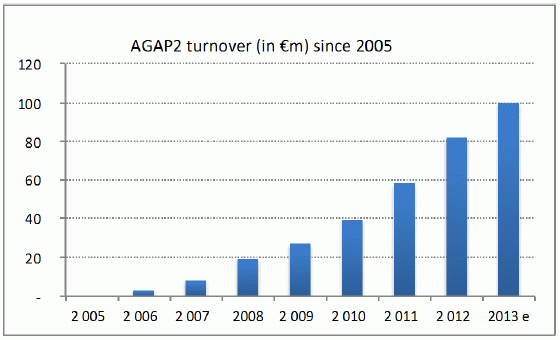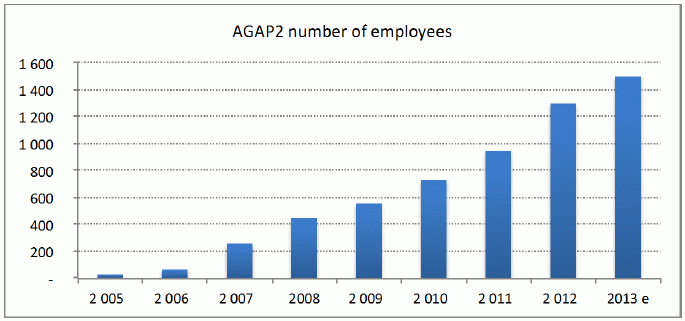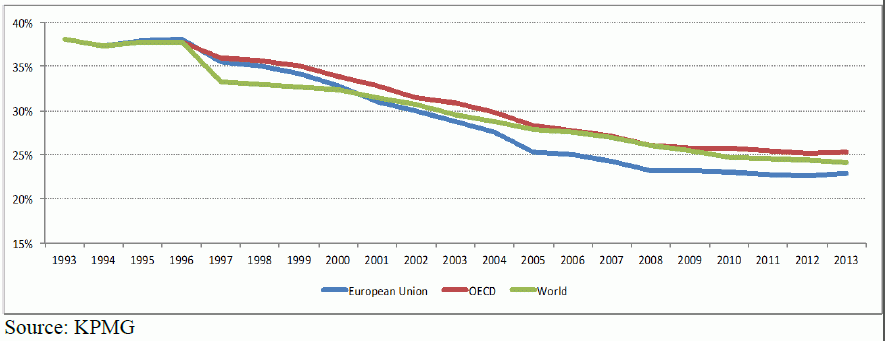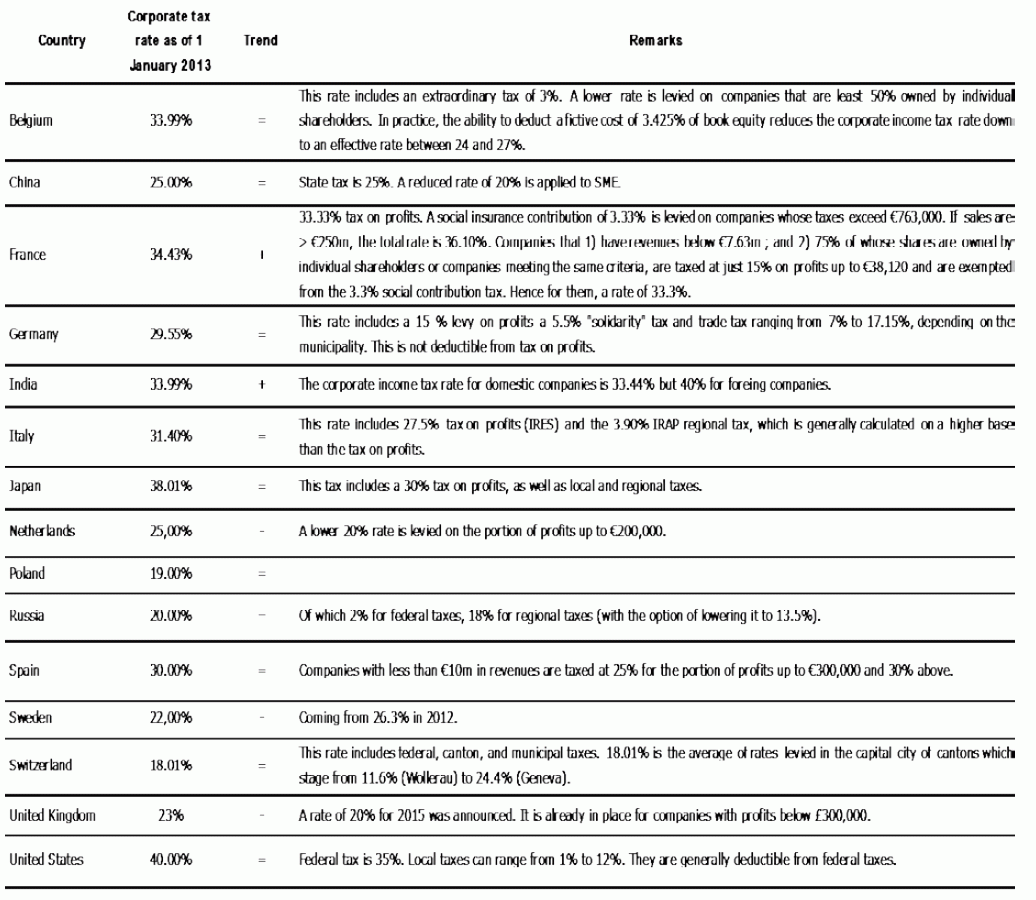Letter number 76 of September 2013
- TOPIC
- STATISTICS
- RESEARCH
- QUESTIONS & COMMENTS
News : The financial policy of AGAP2, a start-up which has become a medium-sized company
AGAP2 is a company set up in 2005 in Lisbon in the area of engineering and operational consulting, specialising in energy and IT systems, with 62% of the company held by its founder-managers and 38% by a business angel.
After seven years of activity, AGAP2 achieved 2012 sales of €83m for a headcount of 1,300 in 6 countries: Germany, Belgium, Spain, France, Portugal, Switzerland.
How was this company able to finance this pace of growth (+73% per year from 2006 to 2012, and "only” +45% over the last 3 years)? There are four explanations.
1/ The characteristics of AGAP2’s sector
The characteristics of a company’s sector will naturally have a determining impact on its financial policy, and in particular, on how capital intensive it is. AGAP2 operates in one of the least capital intensive sectors there are - its ratio of sales to capital employed is around 9. In order to make sales of 9, it has to invest 1, where, at the other extreme, Eutelsat in the satellites sector has to invest 32.
In its sector, AGAP2 enjoys a very low level of tangible and intangible assets, and is mainly concerned with working capital. This is made up, for the most part, of accounts receivable, since inventories in this service activity are non-existent, and accounts payable, mainly staff related (around 70% of costs correspond to personnel expense), which naturally has a very short payment period, even if the social security organisations are paid a bit later. So, while on the income statement, social security expense only accounts for around 27% of total personnel cost, on the balance sheet, debts owed to social security organisations equal debts owed to staff.
Finally, AGAP2’s working capital requirement is rather limited, at around 5% of sales.
2/ Recourse to factoring
AGAP2’s clients are the large industrial group’s in the energy sector. Thanks to factoring, AGAP2 is able to find financial resources easily and at a low cost, at least at a lower cost than a standard bank loan, because the risk of its clients is less for a lender than its own. Eight years ago, we published an article on factoring[1], entitled “Has factoring emerged from the ghetto?”. Already at that time, our conclusion was that it had and since then, the continued development of this source of financing has helped a number of companies to finance their activities.
Even with a working capital requirement of 5% of sales, since receivables account for 17% of its sales, AGAP2 has sufficient accounts receivable to transfer to its factor, even when taking into account the choices that the latter may make, to finance all (and even more) of its working capital in this way.
3/ High level of self-financing
At constant economic elements (margin, capital intensiveness), the higher the level of self financing, the higher the growth rate may be, without any recourse to external financing by using debt or equity. In fact, it can easily be shown[2], in the conditions set out above, that the “natural” growth rate of the company is equal to the product of ROE multiplied by the retention rate.
ROE has always been excellent since the first months in Portugal and continuing up to today, at around 40% (after tax) and without the help of any leverage effect. Other than the low level of capital intensiveness which has already been mentioned, operating margins at around 12%, which is 1 to 2% higher than those of competitors such as Alten and Altran, explain this situation. We’ll remember[3] that the average operating margin of listed companies in Europe is around the same amount, but that these companies are much more capital intensive. Since all of the profits were reinvested in the company until 2008 included, self-financing was maximised. Since 2009, half of the earnings have been paid out in dividends, reducing, at constant capital structure, the company’s potential internal growth.
4/ Moderate use of debt
This is about when AGAP2 started to take out debt in order to finance its first acquisition, with debt partially taking over from self-financing which was now being depleted by the payment of dividends. A moderate dose of debt, since the gross debt EBITDA ratio is only 0.8, and once cash and cash equivalents and securities are taken into account, net debt is negative. The role of debt is in fact to take over partially from equity in the financing of a company when the latter has shown that it is economically viable over a sufficiently long period.
* * *
The shareholder managers of AGAP2 financed the whole of the initial risk of setting up the company using equity capital, which is as it should be. Given the very favourable financial characteristics of the sector, growth was financed without external financing by making use of factoring and by reinvesting all profits before making moderate use of debt to finance an external growth operation.
The next logical step, as long as the excellent operating performances continue and that AGAP2 is able to continue expanding geographically or to other sectors, would be an IPO. The company still has to prove that it can also handle external growth, i.e., basically to successfully integrate teams that previously worked for the competition, as well as it manages internal growth. If it does, it will definitely find the financial resources it needs as there is not doubt that investors will be very positive, based on its performances over time, and its shareholders enjoy liquidity, ten years after their initial investment.
Statistics : Corporate income tax rates around the world
The average corporation tax rate in OECD countries in 2012 was 25.31%, continuing the downward trend it has been on since 1993 (38%)! But the average has been brought down by countries from the former Soviet Block as the scope of the KPMG study has been extended to a number of small countries with rather low corporation tax rates, intended to attract investors.
Corporate income tax rates rate are going down in Sweden and in the UK.
These rates are useful to compute corporate income taxes to be paid on pre-tax profits, to compute free cash flows or cost of capital or produce business plans. But they cannot be compared from one country to the other one to appreciate the tax burden borne by companies. Indeed in some countries some local tax are not levied on the pre tax result but on added value, turnover or the renting value of buildings. And they are in addition to those computed on the pre tax result and shown in this table.
Research : The role of creditors in corporate governance
With Simon Gueguen – Lecturer-researcher at the University of Paris Dauphine
What role do creditors play in corporate governance? According to the traditional view, their main role becomes obvious during situations of bankruptcy. In the absence of any default on payment, they remain passive investors. Three researchers from US universities recently published a study[1] that goes against this idea. Creditors exercise power in the firm well before any bankruptcy proceedings are introduced, and they encourage the creation of value.
From a sample of over 7,000 non-financial firms, listed in the USA between 1997 and 2008, Nini et al show that creditors exercise influence over corporate governance as soon as there is a breach of a clause in a debt contract (covenant[2]). Typically, this may be the failure to comply with certain obligations (compliance with accounting principles, providing the lender with information on a regular basis, taking out insurance, etc.), the carrying out of certain prohibited activities (selling certain assets, excessive investments, dividend payments, etc.) or the failure to comply with certain ratios (cash flows to assets, debt to EBITDA ratio, liquidity ratios, etc.). The frequency of this type of event is a lot higher than payment default – over 40% of firms in the sample committed at least one breach of a covenant during the period studied.
Contractually, creditors enjoy the same rights as they do in the case of a payment default - termination of the covenant and immediate repayment of the principal. In practice, they prefer to renegotiate the terms of the covenants and to put pressure on managers. The amended loan agreements are for lower amounts, run for shorter periods, have higher spreads, more guarantees and more restrictive clauses. They can also exercise their power beyond the covenants by giving advice to management or by requiring better reporting practices.
This empirical study shows that a firm’s financial policy changes substantially after the breach of a clause. The total amount of assets is reduced by 2% compared with similar companies. This reduction is the result of fewer investments and of asset sales. Payments to shareholders (dividends and share buybacks) are reduced by 4% and the total amount of debt by 10%. We also see a sharp increase in changes in the management team. Specifically, the likelihood of a dismissal or a forced resignation of a general manager increases by 60% during the quarter following the breach of the covenant. It is, however, difficult to attribute the whole of this impact to creditors alone.
Nini et al are also interested in the performance, both operational and stock market, of the firm following the breach of a covenant. They show that operating cash flows, having been in decline over the last five quarters prior to the breach, experience an increase of 5% (annualised) over the next three quarters. Most of this increase is the result of a reduction in operating expenses (rather than an increase in sales), reflecting an improvement in operating efficiency. Similarly, shares in these firms show unusually high returns in the month following the breach, here again around 5% annualised.
This last effect is interesting as it runs contrary to the idea that creditors and shareholders necessarily have diverging interests at firms experiencing difficulties. Through their presence and their reinforced vigilance, creditors can make a useful contribution to the sound corporate governance of a firm, for the benefit of all providers of funds.
Q&A : What is a ratchet clause?
The most frequent situation in the financing of start-ups is that investors subscribe their shares at a higher price than those of the founders. When this happens, they insist on the inclusion of a ratchet clause intended to protect them at the time of future fund-raisings, when new shares are issued at a lower price than that which they paid. It may be surprising to see venture capital investors seeking to avoid or to limit a loss, when such investors generally invest in companies at their riskiest stage of development. This is just the counterpart of the entrepreneur’s appetite since the entrepreneur has insisted that the investors pay goodwill before the relevance of the concept and the viability of the economic model have been demonstrated.
It is difficult for an entrepreneur, who has got the investors to pay a price that includes goodwill, to refuse to include such a clause, which will only come into force if the valuation that the entrepreneur has put forward, turns out to be excessive. The investors would argue that the entrepreneur has no faith in his/her valuation and his/her business plan.
The ratchet mechanism, when it is fully implemented (there may be conditions attached that soften the application), triggers the issue by the company of additional new shares to the investors, at a token price, so that they hold as many shares as they would have held as if they had subscribed to the previous capital increase at the price of the capital increase underway. This often results in the founders being highly diluted, which means that they will be a lot less motivated. It is for this reason that a new investor may request that this clause be only partially implemented by the investors in the previous round of fund-raising.
Let’s take the example of a company that issues 1,000,000 shares at €1 to the founders and 800,000 shares at €10 subscribed by the investors. 18 months later, it carries out a second share issue in favour of an investment fund which agrees to invest €5m to hold a total of 36% of the share capital.
The breakdown of the share capital at the outset is:
-
Founders: 56%,
-
Investors: 44 %.
Without a ratchet clause, after the capital increase, we get:
-
Founders: 36 %,
-
Investors: 26 %,
-
Investment fund: 36%.
With the implementation of the ratchet clause, we get:
-
Founders: 28 %,
-
Investors: 44 %,
-
Investment fund: 28 %.
However, since the investment fund requires 36% and not 28% in exchange for its contribution of €5m, more shares will have to be issued to it as it is still contributing the same amount. This means that the issue price of the shares becomes lower. So this means that even more shares have to be issued to the initial investors under the ratchet mechanism, which has the consequence of no longer giving the 36% required by the investment fund. Which means that more shares have to be issued to the initial investors, which has the consequence of… and so on. When the process stops, the breakdown of the share capital is:
-
Founders: 6 %,
-
Investors: 58 %,
-
Investment fund: 36 %.
The ratchet clause has diluted the founders dramatically, so one way or another, something will have to be done to re-motivate them. A pay-to-play clause can limit the exercise of the ratchet clause to investors subscribing to the new round of fund-raising.




